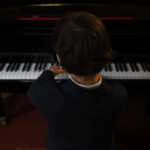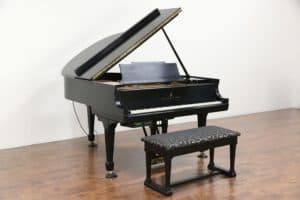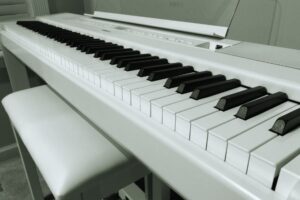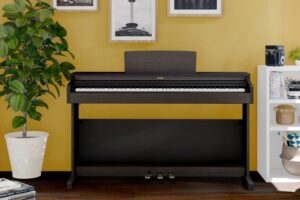Learning to play the piano can take a lot of time and a lot of money if you will pay for lessons. To shorten the time it takes to learn the piano, you can take lessons; but you don’t have to. You can teach yourself to play the piano.
Can you teach yourself to play the piano? Yes, it is very possible to teach yourself to play the piano. It is easier than ever to teach yourself how to play the piano with current technology and resources online. You can start learning how to play the piano with free access to music sheets online, watching videos of piano tutorials, and so much more.
In this article, I’ll go over the following key points and tips:
Key points on teaching yourself to play the piano:
- Get a Good Keyboard
- Familiarize Yourself with the Piano and Identify Middle C
- Learn the Major Keys
- Learn the Chords
- Listen to Sample Pieces and Notice Musical Patterns
- Review Finger Placement
- Research, Research, Research
- Practice
Tips for Teaching Yourself to Play the Piano:
- Pick a Good Online Site, Blog, or Video to Set as a Guide
- Look for Gadgets That Can Help with Your Learning
- Start with Easy Songs to Play
- Dedicate Time and Create a Practice Regimen
- Repetition and Patience Will Pay Off
- Try to Play from Memory
- Record Yourself
- Look for Continuity
- Practice and Then Practice Some More
Those who teach themselves how to play the piano can be equally as good as those who learn from private instructors. Of course, many factors will come into play, such as how much time you spend practicing, how determined and committed you are, and your learning ability.
Learning how to play the piano is a lengthy and tedious process but full of rewards and enjoyment later on.
Read on for some beneficial tips on teaching yourself to play the piano.
Can You Teach Yourself to Play the Piano?
Writing about this topic, a friend comes to mind. He taught himself how to play the piano, practiced every day, got really good at it, and is currently the keyboardist of a popular local band! So, yes, it can be done, and I have seen it happen!
Below, I give some key points on teaching yourself to play the piano:
1. Get a Good Keyboard
Obviously, you can’t teach yourself to play the piano if you do not have one. If you’re undecided between a keyboard and a piano, you can first rent a keyboard so you can test the waters and find out which one is best for you.
When it comes to investment, acoustic pianos can cost anywhere from $1,000 to $10,000, depending on their quality and size. Pianos may be expensive, but their sound and feel are irreplaceable.
Keyboards are much less expensive. Some keyboards only cost $200. But remember that you’ll also need a keyboard stand, sustain pedal, and piano bench. You can also buy more add-ons as you learn how to play it.
Tip: Do not base your choice on price alone. Remember to look for quality sound and weighted keys to get better dynamics. It will be a good investment. And if you’re teaching yourself to play the piano, you’ve already saved a considerable amount of money on piano lessons!
2. Familiarize Yourself with the Piano and Identify Middle C
Sit down, tinker, and play with the keys. It is important to find the middle C. Imagine middle C as the home base. When you know where middle C is, you’ll know where to position your hands on the piano keys. The notes around middle C are used for many piano songs and can be the starting point.
Middle C on Standard 88-key Pianos
Here’s how to locate the middle C on a standard 88 key piano:
Notice that the black keys alternate in groups of twos and threes. The C key is directly on the left side of each group of two black keys. Place yourself in the center of the piano. Identify the C that is closest to the middle of the keyboard. And, that’s it – the middle C. Remember where it is every time you play.
Middle C on Electric Keyboards
Here’s how to locate middle C on an electric keyboard:
Keyboards sometimes have fewer keys than the standard 88-key pianos. Depending on your keyboard’s size, start from the left side and use the guide below to locate middle C.
- 88-key – Middle C is the fourth C
- 76-key – Middle C is the third C
- 61-key – Middle C is the third C
- 49-key – Middle C is the third C
3. Learn the Major Keys
You’ll need to identify the keys and the specific sound of each key. A tip to make this easier is to assign a number to a key. For example:
- 1 = C
- 2 = D
- 3 = E
- 4 = F
- 5 = G
- 6 = A
- 7 = B
- 8 = C
This method helps to identify each C better. Number 1 being middle C, and the 8th can be a higher or lower C.
When you’ve mastered this technique, you can start playing simple songs and replace the numbers for the letters until you’re comfortable enough to use the letters. You’ll probably have to experience some trial and error here, but in the process, you’ll discover what works for you best.
4. Learn the Chords
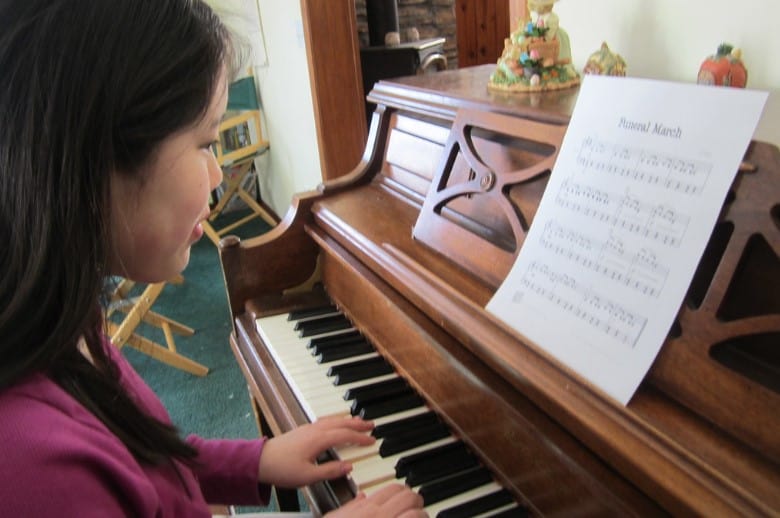
Piano chords are different from piano notes. Basically, piano notes are the sounds you’ll produce from hitting individual keys on the piano. Piano notes run from C to G and then A and B.
On the other hand, piano chords are different. There are different kinds of piano chords, but I’ll just discuss the basic ones here – the major and minor piano chords. You’ll use the first finger, middle, and pinky fingers for the major and minor chords.
Half Steps and Full Steps
You’ll also need to know first about “half steps and full steps.” Let me explain a bit. Let’s take the C key as an example. To make a half step, you go to the key above it. The C key is white. Above it is a black key, which is the half step, and it’s called C#.
The E key does not have a black key above it, so the half step for E is the next key beside it, which is F. F is a white key. The F key is also called E#.
For full steps, it’s the key right next to the note. The C key’s full step is the D key, which is the white key. The E key’s half step is F because it doesn’t have a black key above it. So, the E key’s full step is the black key above F. So far, so good? Okay, great!
Major Chords
For major chords, move two full steps forward and then another 1.5 steps forward. Let’s take the C key again as an example:
- Place your thumb on the C key. Move two keys forward (C to C#, C# to D#, and D# to E).
- Place your middle finger on E. Count 1.5 steps forward (E to F, F to F#, and F# to G).
- Place your pinky finger on G.
And, there you have it – your first major chord!
Minor Chords
A minor chord is almost the same, but you start moving 1.5 steps forward first and then two steps forward. Easy, right? However, there are also complex piano chords that can come after you’ve mastered the major and minor chords.
5. Listen to Sample Pieces and Notice Musical Patterns
To understand how melodies and baselines are out together, you need to learn how to notice musical patterns. All songs are made up of musical patterns, and chords often repeat themselves in a musical piece. Try to identify the chords in the music, and it will be easier for you to play by ear.
6. Review Finger Placement
It is important to learn which finger goes on each key. Refer to a basic piano lesson book or research. Notice that the lessons will tell you that each finger is numbered. The thumb is 1, and the pinky finger is 5.
7. Research, Research, Research
There are lots of ways to get your hands on instructional materials for the piano. Find materials that are consistent with what they say. You may also watch videos of piano pieces to listen to the chords while watching finger placement.
8. Practice
Constant practice is essential if you want to be good at playing any musical instrument. Set a daily schedule for your practice and stick to it.
It doesn’t always have to be playing on the piano. You can watch piano videos, read instructional materials, or study music sheets. Just be consistent with your practice schedule.
Tips for Teaching Yourself to Play the Piano
1. Pick a Good Online Site, Blog, or Video to Set as a Guide
Stick to your choice/s to ensure consistency in playing the techniques and styles you have learned. The things you want to look for on a site that teaches piano lessons are as follows:
- Free Sample Lessons – Of course, you would want to check out if their methods are right for you. So, it makes sense to claim their free lessons and then decide from there.
- Unlimited Lessons – It is best to check that the site adds new material for lessons regularly. A lot of sites with “unlimited lessons” don’t actually add new lessons. And you will need ample lesson materials to progress in piano playing.
- A Detailed Explanation for Each Lesson – When you’ve found sample lessons or unlimited lessons, make sure that the site gives you a clear, detailed explanation of each lesson, perhaps a lesson goal, a lesson activity, or a lesson quiz. Having these features can help you have a foresight of what you will be learning for some time.
2. Look for Gadgets That Can Help with Your Learning
Some keyboards come with software, which you can install on your Mac or Windows. It will help you identify the keys and tell you which ones to press.
3. Start with Easy Songs to Play
It may seem tempting to tackle a difficult song, but this may frustrate you in the end. Choose songs with easy and repetitive chords just to familiarize yourself with the keyboard and finger movement. Push and challenge yourself harder as you go along.
4. Dedicate Time and Create a Practice Regimen
Schedule 1-2 hours a day solely for learning the piano. Work out a practice regimen that is best for you and stick to it every single day. The maximum recommended time to practice is two hours a day. Any longer than that, and you might burn yourself out. Enjoy the learning!
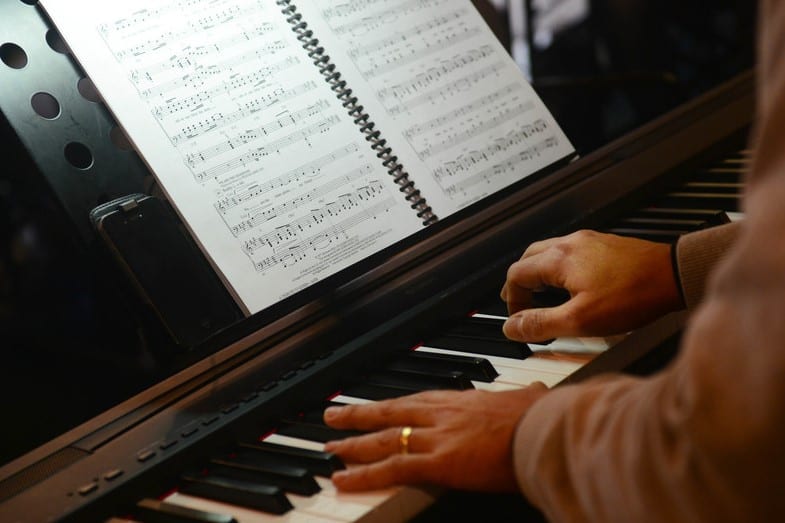
5. Repetition and Patience Will Pay Off
If you find that playing the piano is somewhat difficult, whether a whole musical piece, a chord, or a particular phase, do not stop trying until you perfect it.
Do not, by all means, skip and move on to the next thing. If you do, it can contribute to sloppy piano playing, and you don’t want that. Just keep repeating and be patient. You will get it right!
6. Try to Play from Memory
Go through a song again and again. Eventually, you’ll have memorized certain parts without having to look at the music sheet. Keep going until you can play the whole song from memory.
7. Record Yourself
Recording yourself while playing the piano will help you catch some mistakes. I will stress that it is quite important to correct your mistakes immediately. If you keep making a mistake, it will be challenging to unlearn it.
8. Look for Continuity
I find it best to work with small sections at a time, often starting with the most difficult sections. To work with continuity means that the sections you study overlap each other.
Let’s say you’re studying the difficult sections first, make sure that the easy sections, which will come next, are somehow intertwined with the hard sections. Many pianists claim this method to be very effective and powerful in their learning.
9. Practice and Then Practice Some More
I will share this advice because I have experienced it so, so, so many times. There will be times, normally in the beginning, when you just want to quit, but DON’T! I promise you–it will be a rewarding and beautiful experience when you learn to play the piano.
Keep going, and you will truly be fulfilled when you succeed in teaching yourself to play the piano!
Conclusion – Can You Teach Yourself to Play the Piano?
So, to answer the initial question: Can you teach yourself to play the piano? You certainly can teach yourself how to play the piano correctly!
Follow the key points and tips I outlined in this article, including:
Key points on teaching yourself to play the piano:
- Get a Good Keyboard
- Familiarize Yourself with the Piano and Identify Middle C
- Learn the Major Keys
- Learn the Chords
- Listen to Sample Pieces and Notice Musical Patterns
- Review Finger Placement
- Research, Research, Research
- Practice
Tips on Teaching Yourself to Play the Piano:
- Pick a Good Online Site, Blog, or Video to Set as a Guide
- Look for Gadgets That Can Help with Your Learning
- Start with Easy Songs to Play
- Dedicate Time and Create a Practice Regimen
- Repetition and Patience Will Pay Off
- Try to Play from Memory
- Record Yourself
- Look for Continuity
- Practice and Then Practice Some More
It will all boil down to discipline, consistency, and determination. Many pianists out there did not start with formal piano lessons, yet they have been very successful in piano playing. One example is Paul McCartney, who’s known as one of the band members of The Beatles.
So, if you’re seriously considering teaching yourself to play the piano, you can follow our tips and be set in no time!
Related reading:
How Hard Is It to Learn Piano?
Is Piano Easy to Learn? Plus How to Learn Fast
Best Way to Learn Piano [12 Tips for Learning How to Play Piano]

